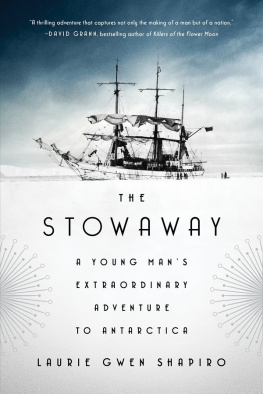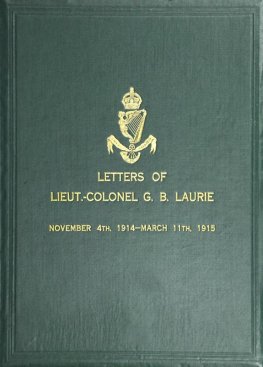Laurie Gwen Shapiro - The Stowaway: A Young Man’s Extraordinary Adventure to Antarctica
Here you can read online Laurie Gwen Shapiro - The Stowaway: A Young Man’s Extraordinary Adventure to Antarctica full text of the book (entire story) in english for free. Download pdf and epub, get meaning, cover and reviews about this ebook. year: 2018, publisher: Simon & Schuster, genre: Non-fiction. Description of the work, (preface) as well as reviews are available. Best literature library LitArk.com created for fans of good reading and offers a wide selection of genres:
Romance novel
Science fiction
Adventure
Detective
Science
History
Home and family
Prose
Art
Politics
Computer
Non-fiction
Religion
Business
Children
Humor
Choose a favorite category and find really read worthwhile books. Enjoy immersion in the world of imagination, feel the emotions of the characters or learn something new for yourself, make an fascinating discovery.
- Book:The Stowaway: A Young Man’s Extraordinary Adventure to Antarctica
- Author:
- Publisher:Simon & Schuster
- Genre:
- Year:2018
- Rating:4 / 5
- Favourites:Add to favourites
- Your mark:
- 80
- 1
- 2
- 3
- 4
- 5
The Stowaway: A Young Man’s Extraordinary Adventure to Antarctica: summary, description and annotation
We offer to read an annotation, description, summary or preface (depends on what the author of the book "The Stowaway: A Young Man’s Extraordinary Adventure to Antarctica" wrote himself). If you haven't found the necessary information about the book — write in the comments, we will try to find it.
The Stowaway: A Young Man’s Extraordinary Adventure to Antarctica — read online for free the complete book (whole text) full work
Below is the text of the book, divided by pages. System saving the place of the last page read, allows you to conveniently read the book "The Stowaway: A Young Man’s Extraordinary Adventure to Antarctica" online for free, without having to search again every time where you left off. Put a bookmark, and you can go to the page where you finished reading at any time.
Font size:
Interval:
Bookmark:
Thank you for downloading this Simon & Schuster ebook.
Get a FREE ebook when you join our mailing list. Plus, get updates on new releases, deals, recommended reads, and more from Simon & Schuster. Click below to sign up and see terms and conditions.
CLICK HERE TO SIGN UP
Already a subscriber? Provide your email again so we can register this ebook and send you more of what you like to read. You will continue to receive exclusive offers in your inbox.

Dedicated to my father
JULIUS SHAPIRO
my hero and lifelong champion.
All that is personal soon rots; it must be packed in ice or salt.
William Butler Yeats

W ith his back against the sunset, a seventeen-year-old boy lingered on the docks along the Hudson River. By his calculations, it was a ten-minute swim from where he stood to the ship.
The new high school graduate waited, his soft grey eyes fixed on the City of New York , moored and heavily guarded on the Hoboken piers. The sun went down at six forty-five this dayAugust 24, 1928but still he fought back his adrenaline. He wanted true darkness before carrying out his plan. At noon the next day, the ship would leave New York Harbor and sail nine thousand miles to the frozen continent of Antarctica, the last frontier on Earth left to explore. He intended to be aboard.
That summer, baby-faced Billy Gawronski was three inches short of his eventual height of five foot eleven, and his voice still squeaked. You are a late bloomer, his doting immigrant mother told him in thickly accented English. Yet the ambitious dreamer, born and raised in the gritty tenement streets of the Lower East Side, was as familiar with Commander Richard Evelyn Byrds flagship as any reporter assigned to cover its launch. The Antarctica-bound barquentine was an old-fashioned multi-masted ship that suggested the previous century, with enchanting square sails arranged against an almost impenetrable maze of ropes. The 161-foot wooden vessel spanned half a city block, her 27-foot beam taller than a three-story building. Sail- and steam-powered and weighing 200 tons, with sturdy wooden sides 34 inches thick, she had seen duty as an Arctic icebreaker for Norwegian seal hunters starting in 1885. On one run in icy waters in 1912, her captain had been the last to see the Titanic ; just ten miles away, hed been afraid to help the sinking ship, as he was hunting illegally in territorial waters. Like so many immigrants, the ship once known as Samson found her name changed when she arrived in America in 1928, becoming the City of New York . She was the most romantic of the four boats in Byrds cobbled-together flotilla, and the one leaving firstwith the greatest fanfareearly the next afternoon.
Several times in his mind that evening, Billy dove into the Hudson and started swimming, only to find his feet firmly on land. But he had been on board the SS New York before. Nine days earlier, he and two thousand other New Yorkers had taken the Fourteenth Street Ferry to Hoboken, New Jersey, and gaped at the City of New York , moored next to the grand Dutch ocean liner the SS Veendam . The crowd was wowed with anticipation. Just past noon, the ships captain, Frederick Melvillesecond cousin of the nineteenth-century author Herman Melvillegave the okay, waving the first sweaty guests up the gangway, their dollar admission supporting the Byrd Antarctica expeditions fund-raising drive. Several members of Melvilles crew, including the chief engineer, Thomas Mac Mulroy, and sixty-year-old veteran sailmaker John Jacobson, joined him in greeting the adoring public. No, he told them, Byrd was not aboard. Everyone still wanted to gawk.
When it had been Billys turn to board, hed wandered the wooden decks, still cargo free to accommodate guests. The poop aft (rear deck) was elevated, housing Commander Byrds cabin, an elegant wood-paneled chart room, and a state-of-the-art radio room with technology that would let the explorers be heard no matter how far they sailed. Under the poop deck were spaces for the machine room and the radio generator. One level down were seven cabinsthe cramped quarters where the men would sleepas well as several storerooms, and lockers for holding mops and paint. He stood in the machine room with other touristsmen and women content to admire all the nifty gadgets. Also aft were the ships engine and oppressively hot boiler room.
None of these places had been right for a hiding spot. Forward proved more promising, with its large focsle (forecastle, a front deck), and a second, smaller focsle in the peak: a narrow hollow under the bowsprit (a thick pole projecting from the upper end of a sailing vessel) of the boats prow (the part of the bow above the water). Here, under this second hidden focsle, Billy had spied a good-sized space in a shelf. The exposed top focsle would be visible to anyone on the ship during the departure ceremonies, but the second focsle would remain dark. Satisfied with his investigation, the lad grabbed one of the commemorative paper cups set aside as a souvenir before heading for the ramp.
Afterward, still on a high, Billy had walked the New Jersey shoreline until hed scouted the lookout site he was in now, a long distance from the ship but not out of reach for a superior swimmer like himself. Another ocean liner had taken the Veendam s place next to the expedition ship in Hobokens busy Pier 1: the SS Leviathan , headed overseas the next day, too. The Leviathan dwarfed its famous ice-bound companion vessel in dock.
With the twilight not yet dissipated, Billy still had an excellent view of the many ships going up and down the brackish southern-flowing Hudson. Could a ship hit him as he swam? He ate what little food hed brought: an apple and an egg salad sandwich. As for what he would eat after that? He hadnt bothered to think about it.
Even under the dimming sky, Billy could make out the shadowed bodies of stationed watchmen, but he was unsure if they were Byrds crew or borrowed Coast Guards keeping vigil. There would be no sneaking up the gangway, the narrow metal plank for boarding. He would have to swim out to the unprotected side of the ship, the side facing the water. Who would think to guard the edges of the ship away from the pier? Once aboard, he did not have a sure grasp on how he would reveal himself to Commander Byrd or justify his presence on the expedition, but he trusted he could wing it.
In Byrd, Americans like Billy now had a superexplorer of their ownsomeone who could stand proudly beside Englands legendary Ernest Shackleton and Robert Falcon Scott, not to mention Norways Roald Amundsen, the crafty strategist who in 1911 had been the first to reach the South Pole, just five weeks ahead of Scotts team. The thirty-nine-year-old blueblood Virginian Dick Byrd was a slight but strong man with a chiseled, smooth-shaven face. He looked the part of a hero and acted like one, too, admired already for the responsible, safety-first ethics he had demonstrated exploring the North Pole by ship and plane in 1926. Now he had set his eye on the South.
Byrds team would be the first American expedition to Antarctica since Lieutenant Charles Wilkes and his exploring party poked around the coast eighty-eight years before, in February 1840. And Wilkes had not even set foot on the continent itself.
When the commanders four ships reached Antarctica, the coldest, windiest outpost imaginable, he would unload a specially designed Ford trimotor three-propeller transport plane with a seventy-foot wingspanthe first commercial aircraft sturdy enough to weather a 120-mile-per-hour flight over the South Pole; only 199 of the planes were manufactured. The wings and fuselage were constructed from corrugated duralumin, a light, strong alloy of aluminum, copper, manganese, and magnesium, while the landing gear and bracing were all steel. Byrds underlings would assemble it on the ice barrier that guarded the continent of Antarctica, and, with the aid of a pilot, he would fly over the polar plateau, proudly dropping the Stars and Stripes from the sky. Two more monoplanes (a plane with only one set of wings) were sailing on other ships farther southbound to 90 degrees south: a small Fokker and an even smaller Fairchild. With the introduction of airplanes to Antarctica, Byrd and his pilots would have the first birds-eye views of its great mysterious interior, and no doubt add to the fragmentary maps of the south polar region, a landmass Byrd believed to be greater than that of the United States and Mexico combinedat least five million miles. But as Billy told his family and friends, no one was sure.
Next pageFont size:
Interval:
Bookmark:
Similar books «The Stowaway: A Young Man’s Extraordinary Adventure to Antarctica»
Look at similar books to The Stowaway: A Young Man’s Extraordinary Adventure to Antarctica. We have selected literature similar in name and meaning in the hope of providing readers with more options to find new, interesting, not yet read works.
Discussion, reviews of the book The Stowaway: A Young Man’s Extraordinary Adventure to Antarctica and just readers' own opinions. Leave your comments, write what you think about the work, its meaning or the main characters. Specify what exactly you liked and what you didn't like, and why you think so.












